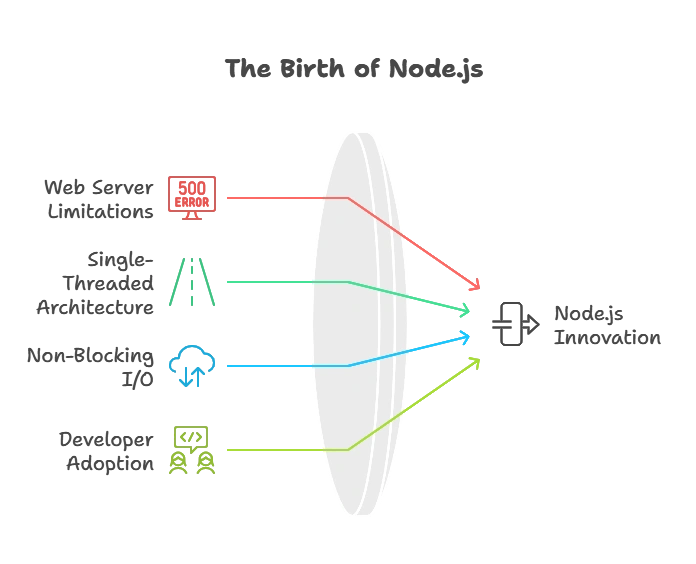What is Node.js ?
Node.js is a powerful and flexible runtime environment that allows developers to execute JavaScript code outside of a web browser. Built on Chrome's V8 JavaScript engine, Node.js is designed to build scalable network applications, making it ideal for server-side programming.
Origin and History
Node.js was created by Ryan Dahl in 2009. Dahl’s inspiration came from the limitations he observed in web server performance, particularly the blocking nature of I/O operations. Traditional web servers like Apache handled each request with a dedicated thread, leading to inefficiency and high memory consumption under heavy load.
Dahl’s solution was to use a single-threaded, event-driven architecture. This approach would handle multiple connections simultaneously with a single thread, using non-blocking I/O to manage tasks efficiently. Node.js was first presented at the inaugural European JSConf on November 8, 2009, and quickly gained traction among developers for its innovative approach.

Features of Node.js
Single-Threaded Event-Driven Architecture: Node.js uses an event-driven, non-blocking I/O model, making it lightweight and efficient. This architecture allows Node.js to handle thousands of concurrent connections with minimal overhead on a single thread.
Non-Blocking I/O: Traditional web servers use blocking I/O, meaning each operation must complete before the next one begins. In contrast, Node.js uses non-blocking I/O, enabling it to process multiple requests simultaneously without waiting for any of them to complete.
JavaScript Everywhere: With Node.js, developers can use JavaScript for both client-side and server-side programming. This unifies development environments and streamlines the development process.
Package Management: Node.js comes with npm (Node Package Manager), the world’s largest software registry. npm provides access to thousands of open-source libraries and tools, making it easy to extend the functionality of Node.js applications.
Scalability: Node.js is designed for scalability. Its event-driven architecture allows it to handle a large number of simultaneous connections, making it suitable for real-time applications like chat servers, online gaming, and live streaming.
Cross-Platform Compatibility: Node.js runs on various platforms, including Windows, macOS, and Linux, providing flexibility and ease of deployment across different environments.
Advantages of Node.js
High Performance: Node.js is built on the V8 JavaScript engine, which compiles JavaScript into machine code. This results in fast execution and high performance, especially for I/O-heavy applications.
Asynchronous and Event-Driven: The non-blocking nature of Node.js allows for asynchronous execution of code, which improves the overall responsiveness of applications. This is particularly beneficial for applications requiring high concurrency.
Large Ecosystem: The extensive npm ecosystem offers a vast array of libraries, tools, and frameworks that simplify development and speed up the creation of applications. Developers can leverage pre-built modules to avoid reinventing the wheel.
Real-Time Capabilities: Node.js is well-suited for real-time applications, such as chat applications and live updates. Its event-driven architecture and WebSocket support enable real-time communication between the server and clients.
Community Support: Node.js has a large and active community that contributes to its development and provides support through forums, documentation, and tutorials. This community-driven approach ensures continuous improvement and a wealth of resources for developers.
Reduced Development Time: Using JavaScript for both front-end and back-end development allows for code reuse and a more streamlined development process. This reduces the time required to build and maintain applications.
Drawbacks
Single-Threaded Limitations: While Node.js’s single-threaded, event-driven architecture is efficient for handling many concurrent connections, it can struggle with CPU-intensive tasks. Since it runs on a single thread, long-running computations can block the event loop, degrading performance.
Callback Hell: Node.js relies heavily on callbacks to handle asynchronous operations. This can lead to deeply nested callback functions, often referred to as “callback hell,” making the code difficult to read and maintain.
Maturity of Libraries: While the npm ecosystem is vast, not all libraries and modules are of high quality or well-maintained. Developers might encounter immature or poorly documented packages, leading to integration issues.
Concurrency Model: Node.js’s concurrency model, while suitable for I/O-bound operations, is not as efficient for handling multi-threaded, parallel processing tasks compared to traditional multi-threaded server environments.
Error Handling: Error handling in Node.js can be challenging, especially with asynchronous code. Errors in callbacks need to be handled explicitly, and failing to do so can lead to unhandled exceptions and potential crashes.
Scalability Challenges: Although Node.js is scalable for many concurrent connections, it can be challenging to scale applications across multiple CPU cores. This typically requires additional tools or external solutions, like load balancers, to distribute workloads effectively.
Security Concerns: The extensive use of third-party modules in Node.js applications can introduce security vulnerabilities. Developers need to be vigilant about updating dependencies and auditing code to mitigate potential risks.
Learning Curve: For developers coming from a synchronous programming background, adapting to Node.js’s asynchronous, event-driven model can be challenging. Understanding and effectively using asynchronous patterns require a different mindset.
Tooling and Debugging: While the Node.js ecosystem has matured, some developers may find the tooling and debugging experience less intuitive compared to other languages and frameworks, particularly for complex applications.
Memory Leaks: Improper handling of asynchronous operations and closures can lead to memory leaks. Identifying and resolving these leaks requires careful coding practices and may necessitate specialized tools for monitoring and debugging.
Node.js represents a significant shift in how server-side applications are developed. Its event-driven, non-blocking architecture, combined with the power of JavaScript, provides a robust platform for building scalable and high-performance applications. With its rich feature set, vast ecosystem, and active community, Node.js continues to be a popular choice for developers worldwide.Happy coding !❤️
